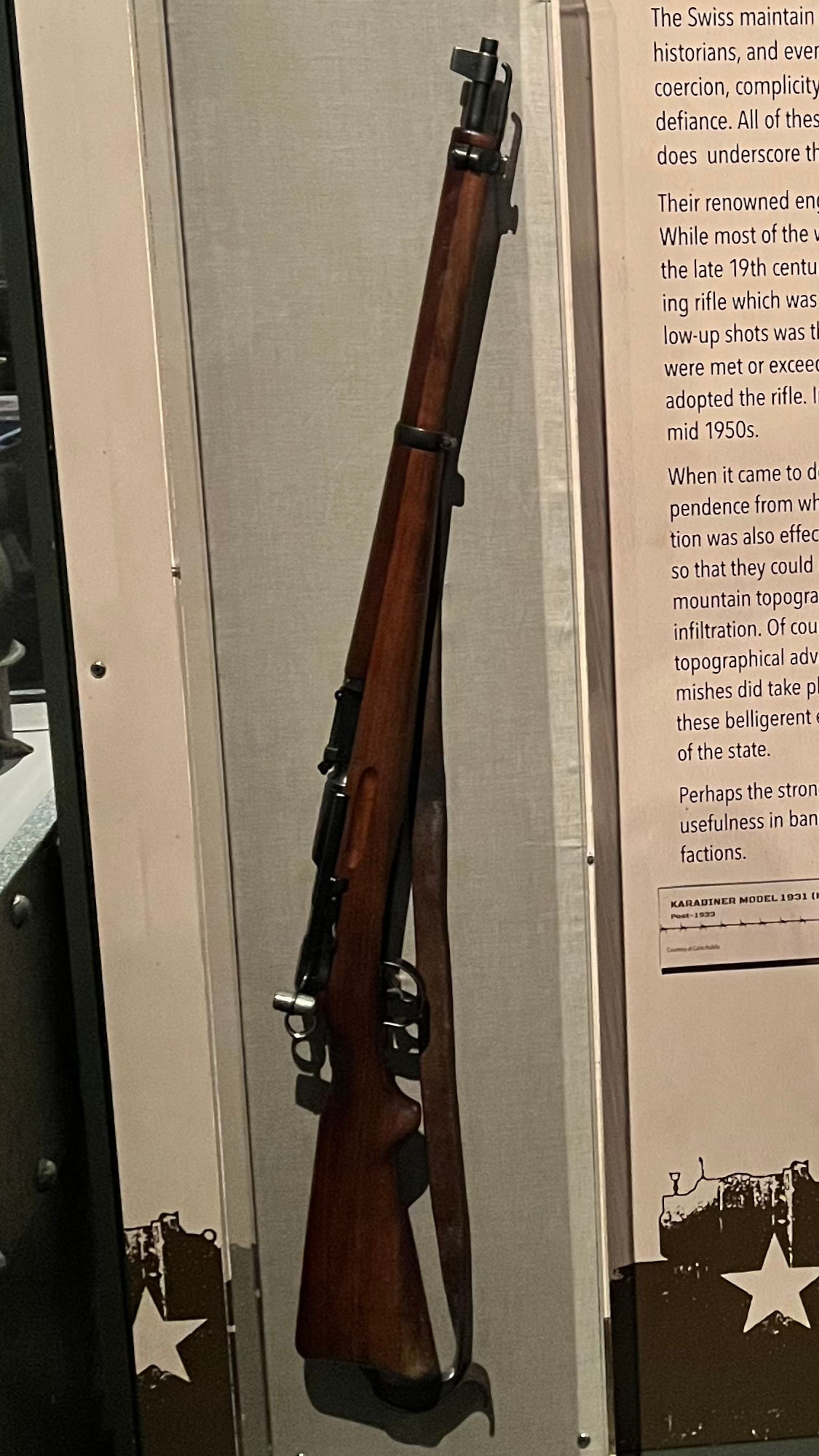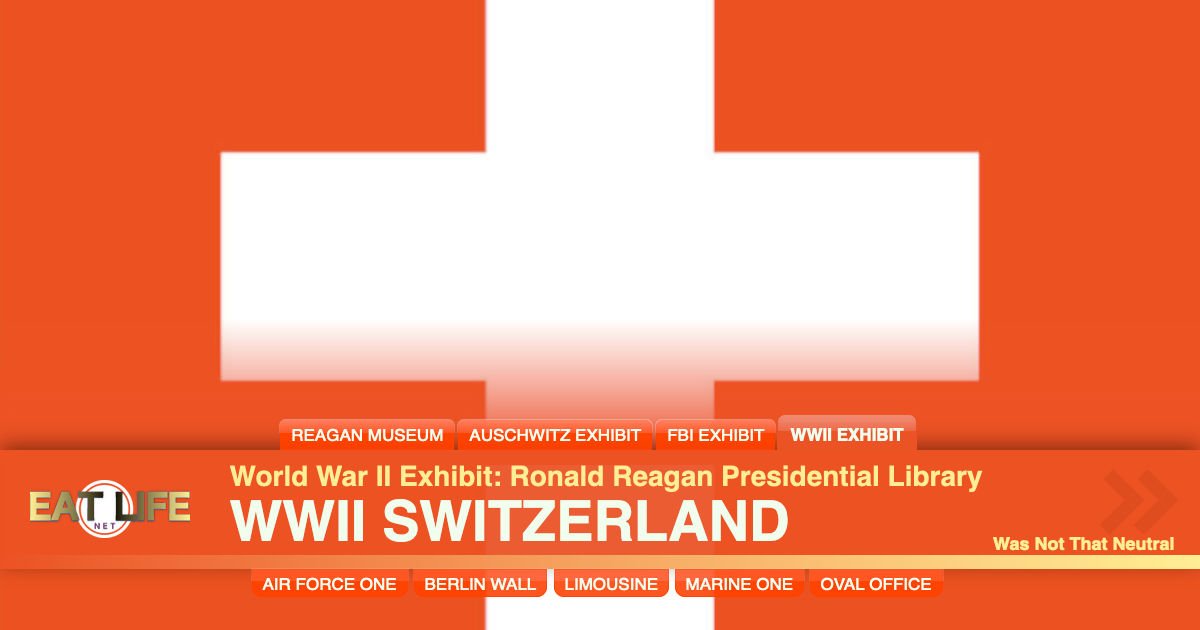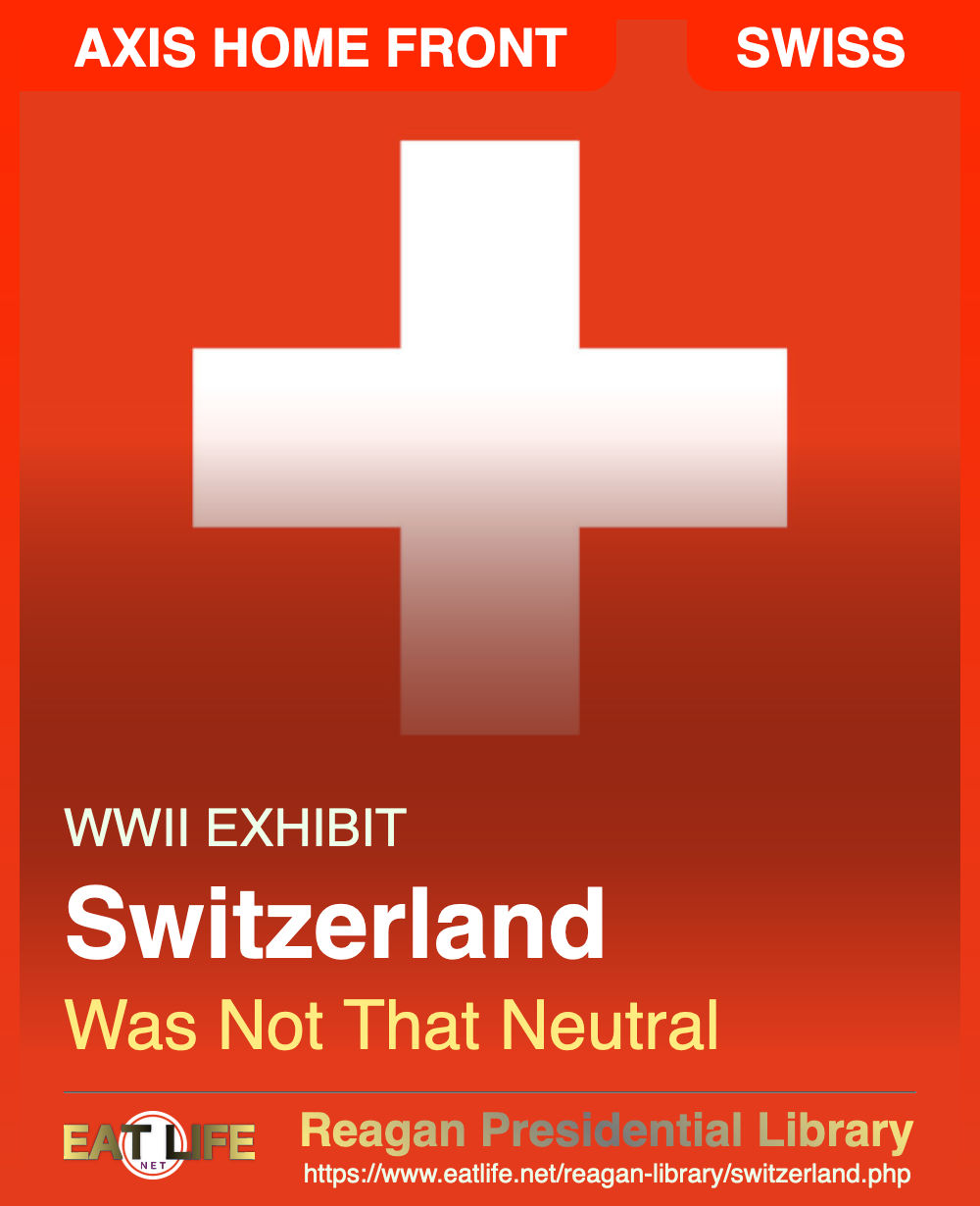Germany chose not to invade Switzerland because:
- Germany's strength was using tanks but Switzerland topography was too rugged for tanks - had to be an invasion of foot - against the highly competent Swiss Army
- There was no military significance to gaining the location - it would just be another country they needed to patrol

The Swiss Way to Protect Neutrality
The Swiss maintain that they were "neutral" during the entire Second World War. However, historians, and even the Swiss themselves, have pointed out not only some elements of coercion, complicity, and convenient pseudo-alliances, but also examples of heroic armed defiance. All of these points more or less undermine the purest definition of "neutrality" but does underscore the tenacity of the Swiss people.
Their renowned engineering prowess even showed in the weapons they fielded for their troops. While most of the world's greatest armies had adopted a rotating bolt action rifle developed in the late 19th century, the Swiss ingeniously created a uniquely Swiss style "straight pull" repeating rifle which was built to exacting standards and very close tolerances. Accuracy and fast follow-up shots was the goal behind the rifle and everyone who tested the rifle felt these goals were met or exceeded. Due to the complexities of the design, however, no other major power adopted the rifle. In Switzerland, though, the straight pull rifle remained in use well into the mid 1950s.
When it came to defending their borders, the Swiss were, and are, fierce protectors of their independence from what would be potential conquerors. Every male member of the Swiss population was also effectively a member of its military, and they each kept military weapons at home so that they could muster quickly and repel foreign attack at a moment's notice. The high mountain topography, which surrounds the small country, also lends towards ease of repelling infiltration. Of course, it would take more than accurate weapons, and fast responding army and topographical advantage to repel a determined foe. Several real battles and many smaller skirmishes did take place between the Swiss and both Axis and Allied forces, although none of these belligerent events by outside aggressors ever significantly threatened the independence of the state.
Perhaps the strongest asset the Swiss had in helping preserve their "neutral status" was their usefulness in banking and their role as an economic facilitator for most all of the other warring factions.

Straight Pull Repeating Rifle
WIKIPEDIAKarabiner Model 1931
K. 31 / Kar. 31 / Mq. 31
A magazine-fed, straight-pull bolt-action rifle. It was the standard issue rifle of the Swiss armed forces from 1933 until 1958 though examples remained in service into the 1970s.
- It has a 6-round removable magazine, and is chambered for the 7.5×55mm Swiss Gewehrpatrone 1911 or GP 11, a cartridge with ballistic qualities similar to the 7.62×51mm NATO/.308 Winchester cartridge.
- Each rifle included a 6-round detachable box magazine with matching stamped serial number.
- A stripper clip can be used to load the magazine from the top of the receiver.
- The Karabiner Modell 1931 replaced both the Model 1911 rifle and carbine and was gradually replaced by the Stgw 57 from 1958 onwards.
Although the K. 31/Kar. 31 is a straight-pull carbine broadly based on previous Swiss "Schmidt–Rubin" service rifles and carbines, the K. 31 / Kar. 31 was not designed by Colonel Rudolf Schmidt (1832–1898) as he was not alive in 1931 to do so. Mechanical engineer Eduard Rubin (1846–1920) was the designer of the 7.5×55mm Swiss ammunition previous Swiss service rifles and the K. 31 / Kar. 31 are chambered for. The Karabiner Modell 31 was a new design by the Eidgenossische Waffenfabrik in Bern, Switzerland under Colonel Adolf Furrer (1873–1958). The first 200 K. 31/Kar. 31s were made in May 1931 for troop trials (serials 500,001 – 500,200), thus the model number of 1931.
The Sinister Face of 'Neutrality'
The Role of Swiss Financial Institutions in the Plunder of European JewryPBSFRONTLINE (1996)
Switzerland's reputation as a neutral safe-haven during World War 11 has been badly tarnished by recent revelations about its wartime transactions with Germany. What began as an examination of the dormant bank accounts of Holocaust victims has gained momentum to include the whole gamut of Swiss financial dealings with the Nazis. In recent months a vast amount of incriminating documentation has been unearthed that reveals the sinister side of Swiss "neutrality".Switzerland served as a repository for Jewish capital smuggled out of Nazi Germany and the states threatened by it, and also for vast quantities of gold and other valuables plundered from Jews and others all over Europe. Right up until the end of the war, Switzerland laundered hundreds of millions of dollars in stolen assets, including gold taken from the central banks of German-occupied Europe.
At the war's end Switzerland successfully resisted Allied calls to restitute these funds, and in the Washington Agreement of 1946 the Allies contented themselves with acceptance of a mere 12% of the stolen gold. Holocaust survivors and the heirs of those who perished met an implacable wall of bureaucracy and only a handful managed to reclaim their assets. As it turns out, some of the dormant accounts were taken by the Swiss authorities to satisfy claims of Swiss nationals whose property was seized by Communist regimes in East Central Europe.
WikipediaDuring World War I and World War II, Switzerland maintained armed neutrality, and was not invaded by its neighbors, in part because of its topography, much of which is mountainous. Germany was a threat and Switzerland built a powerful defense. It served as a "protecting power" for the belligerents of both sides, with a special role in helping prisoners of war. The belligerent states made it the scene for diplomacy, espionage, and commerce, as well as being a safe haven for 300,000 refugees.At the outbreak of World War II in 1939, Switzerland immediately began to mobilize for a possible invasion. The transition into wartime was smooth and caused less controversy than in 1914; the country was fully mobilized in only three days. Parliament quickly selected the 61-year-old career soldier Henri Guisan to be General and by 3 September 430,000 combat troops and 210,000 in support services, 10,000 of whom were women, had been mobilized, though most of these were sent home during the Phoney War. At its highest point, 850,000 soldiers were mobilized.
During the war, under the pan-Germanist Neuordnung doctrine, detailed invasion plans were drawn up by the German military command, such as Operation Tannenbaum, but Switzerland was never attacked. Switzerland was able to remain independent through a combination of military deterrence, economic concessions to Germany and good fortune as larger events during the war delayed an invasion. Attempts by the National Movement of Switzerland, a Swiss political party with Nazi sympathies (which never had more than 4,000 members out of a population of 4.2 million people, less than 0.1%) to effect a unification with Germany failed, largely as a result of Switzerland's sense of national identity and tradition of democracy and civil liberties. The Swiss press criticized the Third Reich, often infuriating its leadership. In turn, Berlin denounced Switzerland as a medieval remnant and its people renegade Germans. Swiss military strategy was changed from one of static defence at the borders to a strategy of attrition and withdrawal to strong, well-stockpiled positions high in the Alps known as the National Redoubt. This controversial strategy was essentially one of deterrence. The idea was to render the cost of invading too high. During an invasion, the Swiss Army would cede control of the economic heartland and population centres but retain control of crucial rail links and passes in the National Redoubt.
Switzerland was a base for espionage by both sides in the conflict and often mediated communications between the Axis and Allied powers by serving as a protecting power. In 1942, the United States Office of Strategic Services (OSS) was established in Bern. Through the efforts of Allen Dulles, the first US intelligence service in Western Europe was created. During the allied invasion of Italy, the OSS in Switzerland guided tactical efforts for the take-over of Salerno and the islands of Corsica and Sardinia.
Despite the public and political attitudes in Switzerland, some higher-ranking officers within the Swiss Army had pro-Nazi sympathies: notably Colonel Arthur Fonjallaz and Colonel Eugen Bircher, who led the Schweizerischer Vaterlandischer Verband. In Letters to Suzanne (French: Lettres à Suzanne, Lausanne, Switzerland, 1949), the Swiss journalist Leon Savary retrospectively denounced in this sense "the occult influence of Hitlerism on the Swiss people during the Second World War, which they were not conscious of being under".
Financial Relationships with Nazi Germany
Switzerland's trade was blockaded by both the Allies and by the Axis. Each side openly exerted pressure on Switzerland not to trade with the other. Economic cooperation and extension of credit to the Third Reich varied according to the perceived likelihood of invasion, and the availability of other trading partners. Concessions reached their zenith after a crucial rail link through Vichy France was severed in 1942, leaving Switzerland completely surrounded by the Axis.Switzerland relied on trade for half of its food and essentially all of its fuel; however, the Swiss controlled vital trans-alpine rail tunnels between Germany and Italy and possessed considerable electrical generating capacity that was relatively safe from air attack. Switzerland's most important exports during the war were precision machine tools, watches, jewel bearings (used in bomb sights), electricity, and dairy products.
Until 1936, the Swiss franc was the only remaining major freely convertible currency in the world, and both the Allies and the Germans sold large amounts of gold to the Swiss National Bank. Between 1940 and 1945, the German Reichsbank sold 1.3 billion francs (approximately 18 billion francs adjusted for inflation to 2019) worth of gold to Swiss banks in exchange for Swiss francs and other foreign currency, which were used to buy strategically important raw materials like tungsten and oil from neutral countries. Hundreds of millions of francs' worth of this gold was monetary gold plundered from the central banks of occupied countries. A total of 581,000 francs' worth of "Melmer" gold taken from Holocaust victims in eastern Europe was sold to Swiss banks.
WIKIPEDIAThe Swiss National Bank
The central bank of Switzerland, responsible for the nation's monetary policy and the sole issuer of Swiss franc banknotes. The primary goal of its mandate is to ensure price stability, while taking economic developments into consideration.World War II
The Swiss National Bank provided 1.2 billion CHF to the Reichsbank. Of this, a value of approximately 780 million CHF of the gold given to the National Bank was gold which had been looted by the forces of Germany. In addition the National Bank also exchanged between 1.2 and 1.6 billion CHF for gold from the Allied forces. During 20 April 1944, gold from the gold reserves of Italy arrived from Como at the railway station within Chiasso.There is controversy over the role of the Swiss National Bank in the transfer of Nazi gold during World War II. The SNB was the largest gold distribution centre in continental Europe before the war. A study by the U.S. Department of State in 1997 notes that the bank "must have known that some portion of the gold it was receiving from the Reichsbank was looted from occupied countries". This was confirmed by the Swiss Bergier commission in 1998 which concluded that the SNB received US$440 million in gold from Nazi sources, of which US$316 million is estimated to have been looted. The gold from Nazi governorship sources was in the form of lingots containing gold looted from central banks of Europe and gold from Jews executed within the concentration camps established by the machination of the Nazi regime, which the SNB took without knowing these facts at the time, nor inquiring to any great degree in the process of its transfer into the possession of the SNB, according to Robert Vogler, a former archivist of the SNB.








